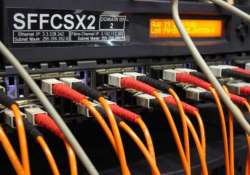Superfast light device for future computers
Washington: An ultra-fast light-emitting device that can flip on-and- off 90 billion times a second and could form the basis of optical computing has been developed.At its most basic level, your smartphone's battery is powering

Washington: An ultra-fast light-emitting device that can flip on-and- off 90 billion times a second and could form the basis of optical computing has been developed.
At its most basic level, your smartphone's battery is powering billions of transistors using electrons to flip on and off billions of times per second.
But if microchips could use photons instead of electrons to process and transmit data, computers could operate even faster. But first engineers must build a light source that can be turned on and off that rapidly.
While lasers can fit this requirement, they are too energy-hungry and unwieldy to integrate into computer chips. Researchers are now one step closer to such a light source.
"This is something that the scientific community has wanted to do for a long time," said Maiken Mikkelsen, assistant professor of electrical and computer engineering and physics at Duke.
"We can now start to think about making fast-switching devices based on this research, so there's a lot of excitement about this demonstration," he added.
The eventual goal is to integrate the new technology into a device that can be excited either optically or electrically.
The study was published in the journal Nature Communications.